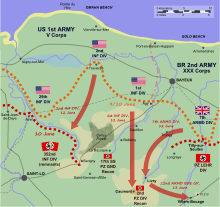Operation Martlet
The attack was to protect the right flank of VIII Corps as it began Operation Epsom, an offensive into the Odon Valley west of Caen, on 26 June.On 23 June, the 51st (Highland) Infantry Division attacked Ste Honorine la Chardonnerette before dawn, captured the village and then repulsed a counter-attack, destroying thirteen German tanks.[6] Operation Epsom, the VIII Corps attack due on 26 June, was vulnerable to a German counter-attack from the Rauray Spur, an area of high ground to the west, which overlooked the line of advance of 15th (Scottish) Infantry Division around the village of Cheux.The divisions were supported by 60–80 88 mm guns of the III Flakkorps, from Saint-André-sur-Orne to Aunay-sur-Odon, which had instructions to engage Allied tanks at ranges greater than 2,000 m (2,200 yd).[18] On the left flank, in the 147th Infantry Brigade area, the 11th Royal Scots Fusiliers advancing towards "Barracuda" on the northern fringe of Fontenay, disappeared into the mist and immediately had many casualties.The survivors reached Fontenay and began to fight through the village hand-to-hand; they then came under fire from Parc de Boislonde to the north-east and were unable to get beyond the road to Tilly.[11] By nightfall, the 49th Division had established a line roughly south-west from Fontenay, about 1 mi (1.6 km) short of Rauray and the high ground which had observation over the VIII Corps area.[23] The 70th Infantry and 8th Armoured brigades prepared to advance south of Fontenay at 6:50 a.m., with Operation Epsom due to begin further west at 7:30 a.m. On the left flank of the 49th Division, the 7th Dukes and the Sherwood Rangers Yeomanry attacked towards "Walrus" at 9:30 a.m., with the first objective being St. Nicholas farm, about 0.5 mi (0.8 km) away.German return fire from tanks and concealed machine-guns forced the infantry under the cover of banks, which had been ranged by Nebelwerfers and were immediately bombarded.The 12th KRRC crossed le Bordel Rau stream at midday but was pinned down beyond and six Dragoon Guard tanks were knocked out attacking the farm.[25] The 12th KRRC, mounted mainly in M3 Half-tracks and Universal Carriers, attacked towards Tessel-Bretteville as the Shermans of the 24th Lancers moved past the east side of Tessel Wood.The attackers then reached the west end of the village, before retiring to Tessel Wood under a smoke screen, due to the number of tank and other vehicle losses.After an artillery bombardment at 11:00 a.m., the DLI fixed bayonets and advanced in line abreast through machine-gun and sniper fire, which caused many casualties and led to a truce being arranged at noon, for both sides to recover wounded.With a Panther company of the 2nd Panzer Division, the kampfgruppe began several hours of mutually costly counter-attacks as the Tyneside Scottish tried to consolidate their positions in the village.[31] The weather on the morning of 29 June was bright and clear and Allied aircraft conducted many ground attack sorties and reconnaissance flights, which found that many German reinforcements were heading for the Odon area.The German counter-offensive by the II SS Panzerkorps, took place south of the 49th Division, either side of the Odon river between Queudeville and Évrecy, against the VIII Corps salient.[32] The 1st Tyneside Scottish found that any movement attracted massed mortar fire from Kampfgruppe Weidinger and a tank periodically harassed the company dug in north of the village.The company was withdrawn to avoid an artillery barrage, preparatory to an attack on the village by the 11th DLI but as soon as the move was spotted, a Nebelwerfer bombardment began and caused many casualties.Nebelwerfer and artillery fire fell on the 10th DLI and 4/7th Dragoon Guards south of Rauray during the day, where several tanks were lost while reconnoitring the forward slope.[33] The Tyneside Scottish selected as a tank killing ground, an area east and south-east of ring contour 110, in front of A and B companies, which had the only good field of observation and dug in four 6-pounder anti-tank guns by the evening.[36] Wireless intelligence, gleaned from the II SS Panzerkorps, led to Bomber Command dropping 1,300 long tons (1,300 t) of bombs during the evening on suspected German tank concentrations at Villers-Bocage which, along with a naval and artillery bombardment, obliterated the town in twelve minutes.The German artillery alternated HE and smoke bombardments so that the tanks could emerge from the smoke-screen, engage suspected British positions and then move on supported by infantry.Later in the day British troops re-occupied the outpost line, supported by Churchill Crocodile flame-throwers, which flamed hedgerows and forced the German infantry into the open, many of whom ran back rather than attempt to surrender and were shot down.[22] In a report on the battle of 1 July written the same day, Lieutenant-Colonel A. E. Warhurst called the German repulse a severe defeat, in which c. 50 tanks had been committed.
Advance of Allied forces, 9–13 June

Fontenay-le-Pesnel in the 49th Division area (Map commune FR insee code 14278)

Topography of the area west of Caen

Tessel-Bretteville area (Map commune FR insee code 14684)

Men of the 2nd Kensington Regiment, 49th (West Riding) Division, attempt to spot a sniper in Rauray, 28 June 1944

Vendes–Cheux area, (Map commune FR insee code 14157)

Longraye, in the 50th Division area (Map commune FR insee code 14376)
Battle for CaenSecond World WarUnited KingdomGermanyGerard C. BucknallEvelyn BarkerKurt MeyerOtto Weidinger49th (West Riding) Infantry Division8th Armoured Brigade12th SS Panzer Division Hitlerjugend2nd SS Panzer Division Das Reich9th SS-Panzer Division HohenstaufenOperation EpsomOperation OverlordAtlantic WallBodyguardFortitudeZeppelinTitanicTaxable, Glimmer & Big DrumCombined Bomber OffensivePointblankTransport PlanPostage AbleTarbrushFabiusCaen canal and Orne river bridgesMerville BatteryMallardAmerican SectorAlbanyBostonChicagoDetroitElmiraNormandy landingsPointe du HocGambitPort-en-BessinAmericanOperation ChastityBritishMulberryBrécourt ManorGraignesLa Haye-du-PuitsSaint-LôCarentanHill 30CherbourgBrévilleVillers-BocageLe Mesnil-PatryNormandy massacresArdenne AbbeyDouvresWindsorCharnwoodJupiter2nd OdonAtlanticGoodwoodVerrières RidgeSpringBluecoatTotalizeHill 140LüttichTractableHill 262ChamboisFalaiseSaint-MaloMantes-GassicourtLa RochelleUshantLa CainePierres NoiresAudierne BayJedburghDingsonSamwestCooneyBulbasketHoundsworthLoytonKiplingDragoonWallace & HardyCemeteriesGerman forcesBattle of NormandyWorld War IIAlliesXXX CorpsSecond ArmyNoyersVIII CorpsOdon Valley50th (Northumbrian) Infantry DivisionJuvigny-sur-SeullesVendesAunay-sur-OdonPanzer Lehr DivisionIII Flak Corps2nd SS-Panzer Division Das ReichII SS PanzerkorpsBayeuxInvasion of NormandyOperation PerchI CorpsCaumont-l'ÉventéFirst US Army3rd Infantry DivisionSword Beach21st Panzer DivisionTilly-sur-Seulles7th Armoured Division1st US Infantry DivisionBattle of Villers-BocageEnglish Channel88 mm anti-tank guns51st (Highland) Infantry Division15th (Scottish) Infantry Division146th Infantry Brigade